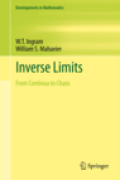
Inverse limits provide a powerful tool for constructing complicated spaces from simple ones. They also turn the study of a dynamical system consisting of aspace and a self-map into a study of a (likely more complicated) space and a self-homeomorphism. In four chapters along with an appendix containing background material the authors develop the theory of inverse limits. The book beginswith an introduction through inverse limits on [0,1] before moving to a general treatment of the subject. Special topics in continuum theory complete the book. Although it is not a book on dynamics, the influence of dynamics can be seen throughout; for instance, it includes studies of inverse limits with maps from families of maps that are of interest to dynamicists such as the logisticand the tent families. This book will serve as a useful reference to graduatestudents and researchers in continuum theory and dynamical systems. Researchers working in applied areas who are discovering inverse limits in their work will also benefit from this book. An elementary introduction to inverse limits through inverse limits on [0,1] is included in the first chapter. The general theory of inverse limits is presented for compact Hausdorff spaces over directed sets using set valued functions in chapter two. Special topics from continuum theory such as indecomposability are discussed in detail An appendix containing mostly an introduction to the topology of the Hilbert cube is included. An extensive bibliography listing much of the literature on inverse limits is a part of the book. INDICE: Inverse Limits on Intervals. Inverse Limits in a General Setting. Inverse Limits in Continuum Theory. Brown’s Approximation Theorem. Appendix: An Introduction to the Hilbert Cube. Bibliography. Index.
- ISBN: 978-1-4614-1796-5
- Editorial: Springer New York
- Encuadernacion: Cartoné
- Páginas: 215
- Fecha Publicación: 28/12/2011
- Nº Volúmenes: 1
- Idioma: Inglés
